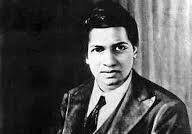Srinivasa Ramanujan, often referred to as Ramanujan, was an Indian mathematician who made significant contributions to the field of mathematics in the early 20th century.
Early Life and Education of Srinivasa Ramanujan
Srinivasa Ramanujan was born on December 22, 1887, in Erode, a town in the state of Tamil Nadu, India. He hailed from a modest family and his parents were K. Srinivasa Iyengar, a clerk in a cloth merchant’s office, and Komalatammal, a housewife. Ramanujan’s family belonged to the Brahmin caste, which traditionally held a high regard for education and scholarship.
Education played a crucial role in Ramanujan’s life, although his formal education was somewhat limited. He attended local schools in Kumbakonam and later in Madras (now Chennai). Ramanujan was a bright student with a particular affinity for mathematics, but his education was disrupted due to financial constraints and health issues.
Despite these challenges, Ramanujan’s deep passion for mathematics led him to pursue independent study, devouring numerous textbooks and tackling complex mathematical problems on his own.
In 1909, Ramanujan secured a clerical position in the Madras Port Trust, which provided him with a stable income but also gave him the freedom to continue his mathematical pursuits. During this time, he immersed himself in mathematical research, making remarkable discoveries and developing his unique mathematical style.
Ramanujan’s lack of formal education in mathematics raised eyebrows when he first sought recognition for his work. However, his exceptional talent caught the attention of renowned mathematicians, including G.H. Hardy, who recognized the extraordinary nature of his mathematical insights.
In 1913, Ramanujan received a scholarship from the University of Madras, which allowed him to continue his mathematical studies. With the support of Hardy, he traveled to England in 1914 to work with him at Trinity College, Cambridge. Ramanujan’s time in England marked a turning point in his career, as he collaborated with Hardy and other mathematicians, and his work began to receive wider recognition.
Ramanujan’s Personal Life
Ramanujan’s personal life was marked by various challenges and tragedy. He faced health issues throughout his life, including recurring bouts of illness during his time in England. The unfamiliar climate and dietary changes in England took a toll on his health, and he struggled with tuberculosis and other ailments. Despite his deteriorating health, Ramanujan continued to produce remarkable mathematical results.
In 1918, Ramanujan married Janaki Ammal, a young girl chosen by his parents. However, their marriage was not without difficulties. Ramanujan’s focus on mathematics often left him emotionally distant from his wife, and the strain of his declining health and financial struggles affected their relationship.
Tragically, Ramanujan’s life was cut short at the age of 32. He passed away on April 26, 1920, in Chennai, India. His untimely death left a void in the mathematical world, robbing it of a brilliant mind that had the potential to contribute even further to the field.
Ramanujan’s Achievements
Despite lacking formal training in mathematics, Ramanujan independently developed numerous groundbreaking theorems and formulas. His work primarily focused on number theory, infinite series, mathematical analysis, and continued fractions. Ramanujan was known for his remarkable intuition and ability to perceive patterns and relationships in numbers.
Ramanujan’s breakthroughs began in his early twenties when he started working on his own mathematical research. His first significant publication was in 1911, in the Journal of the Indian Mathematical Society, where he presented his results on Bernoulli numbers and Euler’s constant. This publication caught the attention of British mathematician G.H. Hardy, who recognized Ramanujan’s exceptional talent and invited him to Cambridge University in England.
Ramanujan’s collaboration with Hardy was highly productive and led to numerous groundbreaking discoveries. Together, they worked on topics such as partitions of numbers, the theory of prime numbers, and the properties of various mathematical functions. Ramanujan’s work on the partition function, which determines the number of ways a number can be expressed as a sum of positive integers, was particularly influential.
Ramanujan’s formulas and theorems are known for their elegance and depth. They often involved infinite series and continued fractions, revealing hidden connections between different areas of mathematics. His work on modular forms and mock theta functions, in particular, has had a profound impact on modern number theory and has found applications in various branches of mathematics and physics.
During his short life, Ramanujan produced nearly 4,000 mathematical results, many of which were published posthumously. Tragically, his promising career was cut short by illness, and he passed away on April 26, 1920, in Chennai, India, at the age of 32. His untimely death deprived the mathematical community of a brilliant mind that could have continued to push the boundaries of mathematical knowledge.
Ramanujan’s legacy continues to inspire mathematicians and researchers to this day. His work has been instrumental in the development of various branches of mathematics, including number theory, analysis, and combinatorics. His notebooks, containing his unpublished theorems and formulas, are still studied and explored by mathematicians, often leading to new discoveries and insights.
In recognition of his contributions to mathematics, Ramanujan has received numerous posthumous honors and awards. In 2012, he was awarded the Padma Vibhushan, India’s second-highest civilian award, and in 2018, the International Mathematical Union named a newly discovered asteroid after him—”(232104) Ramanujan.”
Here are some lesser-known facts about Srinivasa Ramanujan:
1. Self-Taught Mathematical Prodigy: Ramanujan was mostly self-taught in mathematics. He developed his skills by studying various mathematics textbooks and working through problems on his own. His lack of formal training makes his achievements even more remarkable.
2. Early Mathematical Genius: Ramanujan’s mathematical abilities were evident at a young age. By the age of 13, he had mastered trigonometry and had independently developed many theorems and formulas.
3. Tryst with Number 1729: Ramanujan had a fascination with the number 1729. When he fell ill while in England, his collaborator G.H. Hardy visited him in the hospital and remarked that the taxi he took to get there was a rather dull number—1729. Ramanujan immediately replied, “No, Hardy! It is a very interesting number. It is the smallest number expressible as the sum of two cubes in two different ways.”
4. The Lost Notebook: Ramanujan’s notebooks are renowned for containing a wealth of his mathematical discoveries and formulas. However, one notebook, known as the “Lost Notebook,” was discovered much later in 1976. It contained over 600 original mathematical results that were previously unknown.
5. Highly Composite Numbers: Ramanujan made significant contributions to the study of highly composite numbers, which are integers with more divisors than any smaller positive integer. He developed formulas and approximations for the distribution of highly composite numbers, enriching the understanding of these special numbers.
6. Influence of Hindu Deities: Ramanujan often attributed his mathematical insights to the influences of Hindu deities. He believed that the goddess Namagiri would appear in his dreams and reveal mathematical formulas to him. He credited his work to divine inspiration and once said, “An equation for me has no meaning unless it expresses a thought of God.”
7. Ramanujan’s Taxi: There is a famous anecdote about Ramanujan and his collaboration with Hardy. While riding in a taxi with Hardy, they passed a taxi number, 1729, which Hardy thought was uninteresting. Ramanujan immediately corrected him, stating that it was the smallest number that could be expressed as the sum of two cubes in two different ways: 1^3 + 12^3 and 9^3 + 10^3. This incident has become known as “Ramanujan’s Taxi.”
These lesser-known facts shed light on the unique personality and extraordinary achievements of Srinivasa Ramanujan, showcasing his mathematical brilliance as well as the fascinating aspects of his life and work.
Ramanujan’s story is not only a testament to his extraordinary mathematical abilities but also a reminder of the power of human intuition and the potential for brilliance that can emerge from unexpected places. His life and work continue to inspire generations of mathematicians and serve as a symbol of the beauty and elegance of mathematics.
By: SIDHARTHA MISHRA
Write and Win: Participate in Creative writing Contest & International Essay Contest and win fabulous prizes.
















